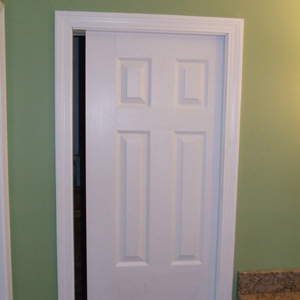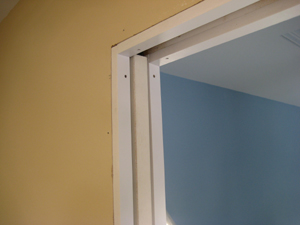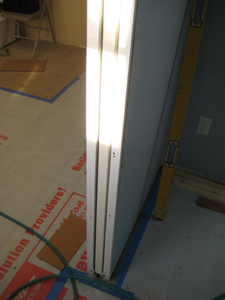How To Trim Pocket Door Jambs




Pocket doors are a really great space saver and they’ve become extremely popular with today’s floor plans. Pocket doors slide on an overhead rail system that allows the door to be slid into a pocket in the adjacent wall. Pocket doors can even match all the other doors in your home and appear to be a regular door when it’s closed. Installing a pocket door isn’t very difficult but it does require some different trim details.
Trimming Pocket Door Jambs




On the other side you just install a full width piece of jamb trim from floor to top. If you want you can install a fake jamb stop to mimic a traditional hung door. Once the jambs are installed you can install casing in the same fashion as the regular doors. Just be careful not to use long fasteners as you’ll hit the door in the pocket. I recommend glueing the trim on and using short brad nails.
Recent Posts
Framing Stick Nailer vs Coil Nailer
Which is Better a Stick Nailer or Coil Nailer? Framers have many choices in nailers…
How Many Roofing Nails Per Square of Shingles
Estimating How Many Nails for a New Roof When it comes to estimating materials for…
Composite / PVC Decking – Layout Tips & Advice
Composite / PVC Decking Layout Tips and Advice Composite and PVC decking have really changed…
Benefits of an ERV System (Energy Recovery Ventilator)
Benefits of ERV Systems (Energy Recovery Ventilator) If you're building a new home or doing…
Vermiculite Attic Insulation Abatement
Vermiculite Attic Insulation If your home was built before 1990 there is a chance it…
Nuisance Tripping of AFCI (Arc Fault) Circuit Breakers
Arc Fault (AFCI) Circuit Breakers Tripping Often An arc-fault circuit interrupter (AFCI) or arc-fault detection…
View Comments
INSTALLING JAMBS IN THIS MANNER REQUIRES THE REMOVAL OF BOTH CASING AND JAMB TO SERVICE THE DOOR. THE CORRECT WAY IS TO INSTALL THE CASING WITH THE INSIDE EDGE FLUSH WITH THE ROUGH POCKET DOOR FRAME AND THEN USING STOP MOLDING ON THE INSIDE EDGE OF THE JAMB, WHEREAS THE CASING AND STOP MOLDING JUST MEET AT THEIR INSIDE EDGES. WHEN INSTALLED THIS WAY ALL THATS REQUIRED TO SERVICE THE DOOR IS TO REMOVE JUST THE STOP MOLDING.
@ Tom - This is not true. The only thing that you need to service the door in this situation is to remove one small piece of jamb on the top. We install that piece with trim screws which makes it very easy to remove.
Not to make problems but I agree with Todd.I'm a finish carpenter from Ontario canada. The proper way to finish a pocket door is to jamb out the frames. Yes this does make it harder to service to door, so extra care should be taken when installing the door.
Question, the Johnson pocket door frame installed by the framing carpenters has a double 1-by piece at the top by the guide rail. Is the second one to be removed? It appears to be stapled on and is lower than the rail itself. Also in the area in which the rollers slide in, is there any way to put a block from one side to the other to avoid seeing the metal bracket that is visible when the door is open?
@ Roy - Any chance you could email me some photos? If there's something stapled below the upper guide rail then it's probably temporary especially if it's in the way of the door. When the door is open you will always be able to look up into the "header" and see the track, or am I mis-understanding your question?
Is it possible to get instructions how to do this in Spanish?
Although, we have this in our home in USA...We are building a home now in CHile, and they are not familiar with this concept.
@ Gina - I wish I could help out but my Spanish is limited to saying hello. Maybe a reader knows Spanish well enough to translate. Best of luck.
I like Todd install ripped 1x, anywhere from 1 3/8" to 1 1/2", on the top and back side jamb but on the inside use 3 trim screws and do not fasten the casing to the jamb. Access to the release mechanism is swift and painless. Also what is not mentioned is that where the door hits the bumper inside the wall, I fasten a piece of 1x to the door edge to keep the door from dropping to far back into the pocket frame.
Ken
Artisan Home Design
Hi!! Todd thank for you article!! I have a question about pocket doors. I am remodeling my bathroom, and I want to replace the existing door to a pocket door since the wall is already there, do I have remove the drywall in both sides in order to install the pocket door? I was going to just remove the wall that is already damage (inside the bathroom) only.
thank you for all you help!!
Mario.
Pocket doors take up twice the width of the door. So if you have a 36" wide pocket door you'll need to have a rough opening that is 36" times two plus another two inches (typically). So that means you'll need to tear apart the wall for 74" plus or minus. This is required to install the actual frame for the pocket door.
So...to answer your question...yes you'll have to open both sides of the wall.
I replaced a standard swing for with a pocket door in my bathroom. I need to build the jamb out to cover the gap and I also paved furring strips on the interior wall so as to place electrical switches upon entry. How would I go about about building the jamb out to close the gap and where would I affix the jamb material to on the pocket door stiffeners? Thank you
Justin - Not sure I understand completely what you're trying to do. Can you email me a picture? todd "at" frontstepsmedia "dot" com.
Hello, do you think it would be a good idea to add door check as well as jamb to both decorate and guide the door better?
Very helpful! Thank you!
Thanks for this info. I have installed my pocket door in a hallway with several other doors, all of which have panels. I've installed it so the door panel is at the same height as the other doors. I want the head casing to line up, also. How do you address the detail of needing trim to cover the gap at the top of the door? I feel the head casing needs to be the same material as the others adjacent, so if I duplicate the other casings, the head jamb would only show with a 1/8 reveal- do I add another piece of trim with another reveal to cover the gap, or just make the "head jamb" piece look thicker?
Not sure I entirely understand your question. When you rip pieces for the jambs, you should be able to rip them so that the thickness creates the same "finished" door opening as your other doors, then when you case it, it looks the same.
Are there special considerations or steps that need be taken to install the pocket door if I want a trimless finish? Would vinyl drywall corner bead be required?
That's going to be a VERY tricky detail. You will likely have to create a custom end jamb that ties into the wall board, but it will likely crack.